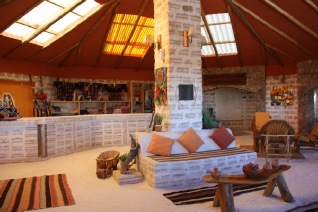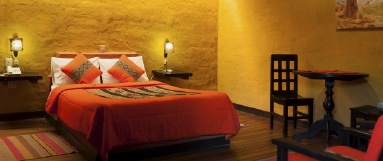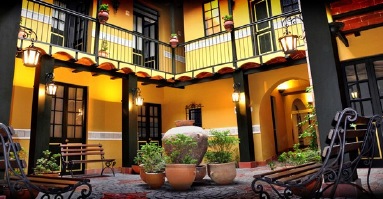What makes this trip special?
Adobe in the Desert
San Pedro de Atacama
Salt Flats and Lagoons
Salar de Atacama and Altiplanic Lagoons
City life beside the Andes
Santiago
Astrology in the Atacama
Star gazing in San Pedro
High lakes biosphere reserve
Lauca National Park
The rugged south-west
Colourful lagoons and snow-capped volcanoes
Volcanic colours
Tunupa Volcano
The largest salt lake in the world
The Uyuni Salt Flats
Silent witnesses of Bolivia's mining heyday
Uyuni's train graveyard
Itinerary
-
- Day Overnight
-
1
Santiago
-
2
San Pedro de Atacama
-
3
San Pedro de Atacama
-
4
San Pedro de Atacama
-
5
Ojo de Perdiz
-
6
Ojo de Perdiz
-
7
Uyuni
-
8
Uyuni
-
9
Tunupa
-
10
Sajama
-
11
Sajama
-
12
Putre
-
13
Arica
-
14
Santiago
-
- For the detail of each day click the ‘Day-by-day’ tab above.
Day-by-day itinerary for 'Touch the Sky: An Expedition through the Deserts of Chile and Bolivia'
Fly from Santiago to Calama, Moon Valley with an evening astronomical tour
Atacama Salt Flats & Altiplanic lagoons
Taito Geysers & Machuca Village
Drive to Uyuni via the train Graveyard
Travel on to the Tunupa Volcano
Day in Sajama National Park
Drive through Lauca on into Chile and Putre.
Guide prices for 'Touch the Sky: An Expedition through the Deserts of Chile and Bolivia'
| options |
based on |
all year |
low season |
mid season |
high season |
peak season |
other season |
| mix of tourist and mid-range hotels, shared touring in Chile and private touring in Bolivia |
2 people sharing |
£5,585 |
|
|
|
|
|
Prices are per person and include:
- excursions and local guides as described (shared touring in Chile, private touring in Bolivia)
- all accommodation
- all travel in Bolivia and Chile, including internal flights
- meals as indicated (B = breakfast, L = lunch, D = dinner)
Prices do not include:
- international flights
- travel insurance
- any optional excursions you may buy locally
- items of a personal nature such as drinks, tips, laundry, etc
- airport and departure taxes if these are not included in the flight ticket
Customer reviews for
'Touch the Sky: An Expedition through the Deserts of Chile and Bolivia'
Recent reviews are shown here from holidays based on this initial design. In each case the itinerary may have been modified
(a little or a lot) to suit the individual traveller.
Seasonal information for 'Touch the Sky: An Expedition through the Deserts of Chile and Bolivia'
Hotels for 'Touch the Sky: An Expedition through the Deserts of Chile and Bolivia'
Days 2 - 3
Luna Salada
edge of the Salt Flats
Average rating 4.5 (6 ratings)
Located at the shores of Bolivia's Uyuni salt flats Luna Salada is built almost exclusively from blocks of salt. There are 49 comfortable rooms and suites fusing Andean-inspired décor such as bright, locally woven fabrics with walls and furniture made from locally harvested salt. All have plush bedding, soundproofing, central heating/air conditioning system, private bathrooms, laptop sized safe, hairdryer, wifi. Some have views overlooking the salt flats.
Facilities include a bar/lounge area with easy seating, fireplace, pool table, library area and TV, restaurant 'Tunapuna' which looks out over the salt flats and specialises in Andean cuisine with an inventive twist, Spa Luna with a steam room and hot tub offering a range of massages and treatments. A variety of excursions in the local area can be booked through the hotel.

Lounge area
Day 5
Jardines de Uyuni
Uyuni town
Average rating 4.5 (2 ratings)
Jardines de Uyuni is an attractive small hotel, well located close to the centre of Uyuni town. Staff create a friendly atmosphere and the 25 rooms are very well kept, all with electric or central heating and hot water. There is Wi-Fi in the communal areas, whilst there is also a small swimming pool and spa area, along with a restaurant and bar.

Matrimonial room
Day 6
Hotel Naira
La Paz
Average rating 4.7 (7 ratings)
Located in a colorful, colonial-style building in the heart of La Paz. Near to the Basilica of San Francisco and a 5-minute walk from El Mercado de las Brujas, ('Witches' market').
Hostal La Naira contains 32 rooms, all including free wifi and cable TV. Room service is available.
Other aminities: international restaurant/café, pub, warm TV lounge and charm and delightful courtyard.

Courtyard